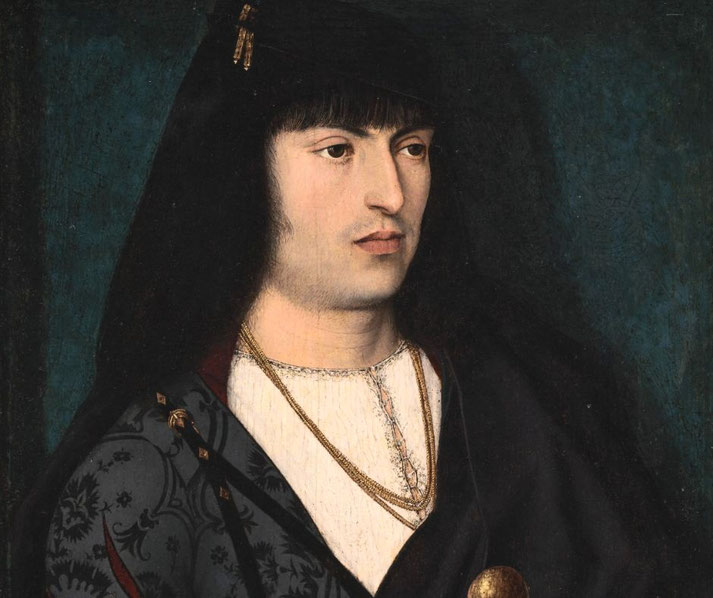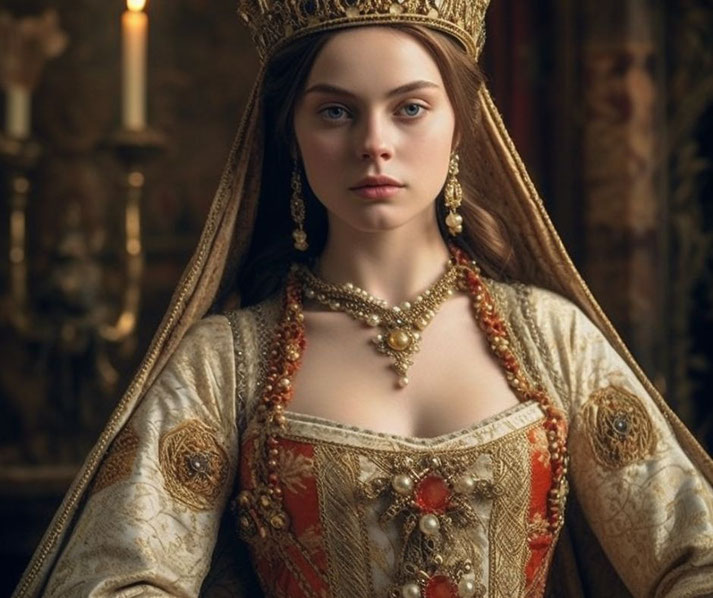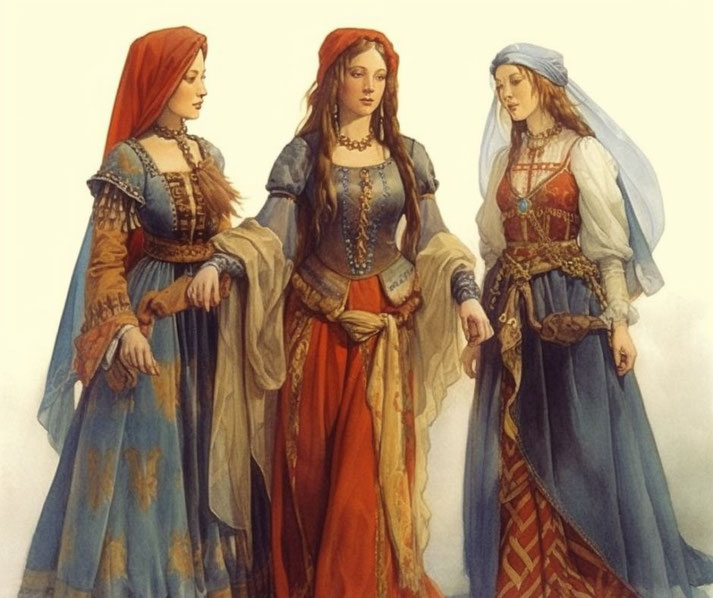Fashionably feudal: What did people wear in the Middle Ages?

The medieval period stands out as one of the most fascinating eras, a time of knights and castles, kings and queens, and significant social, political, and cultural transformations.
An integral thread woven into this fabric of history is fashion - a potent symbol of power, status, and identity in medieval society.
Medieval fashion was more than just a practical necessity; it was a language spoken by all, but understood in its full complexity only by the elite.
The quality, color, and style of one's clothes were a clear reflection of one's position in the rigid social hierarchy.
Beyond the societal norms, fashion served as a mirror to the soul, reflecting not just who one was, but who one aspired to be.
When was the Middle Ages?
The Medieval period, also known as the Middle Ages, was a significant era in European history that spanned from the 5th to the late 15th century.
The period commenced with the fall of the Western Roman Empire and transitioned into the Renaissance and the Age of Discovery.
It's a vast period, often divided into the Early, High, and Late Middle Ages, each with its own distinct socio-political environment, cultural nuances, and of course, fashion trends.
The Early Middle Ages, also known as the Dark Ages, from the 5th to the 10th century, were characterized by invasions, migrations, and political fragmentation.
Clothing during this era was largely utilitarian, designed for functionality and warmth rather than style or status.
However, it was during these centuries that the seeds of medieval fashion were sown, with distinct styles beginning to emerge among different social classes.
The High Middle Ages, from the 11th to the 13th century, was a time of profound change.
The development of cities, the crusades, the flowering of chivalry, and the establishment of universities all had significant impacts on society, including fashion.
The clothing became more varied and elaborate, reflecting the increasing wealth and power of the nobility and the rise of a prosperous merchant class.
The Late Middle Ages, from the 14th to the late 15th century, were a time of crisis and transition.
The period was marked by events such as the Hundred Years War, the Black Death, and the Peasants' Revolt.
These events had profound social consequences, and fashion was no exception.
Clothing trends became even more diverse, with a sharp contrast between the austere, somber attire dictated by the Church and the ostentatious styles favored by the nobility.

The social role of clothes
In the medieval era, clothing was far more than a basic human necessity; it was a tool of communication, an expression of identity, and a marker of social hierarchy.
Every element, from the choice of fabric to the color and cut, was steeped in symbolism and sent clear messages about the wearer's status, occupation, and even moral character.
A cornerstone of this sartorial communication was the stark delineation between the classes.
The nobility, church officials, and the emerging bourgeoisie could afford rich fabrics such as silks, velvets, and brocades, dyed in vibrant, costly colors.
These high-quality materials were often heavily ornamented with intricate embroidery, fur trims, and even precious gemstones, indicative of wealth and power.
In stark contrast, the clothing of the peasantry was characterized by simplicity, made from affordable materials like wool or linen, in natural or dull colors that were easy and cheap to produce.
How the rich dressed
In the medieval world, fashion was an explicit expression of status and wealth, and nowhere was this more evident than in the attire of the nobility.
Their clothes, characterized by fine fabrics, intricate embellishments, and vibrant colors, were not just about personal style but were carefully curated to project power, wealth, and sophistication.
Silk, velvet, brocade, and fur were the preferred materials for the garments of nobles due to their luxury and rarity.
The clothing was often dyed in rich, vibrant hues such as red, purple, and gold, colors that were expensive to produce and thus were associated with affluence.
The wealthy would adorn their outfits with precious gemstones, pearls, and gold or silver thread embroidery, further underlining their status.
Men's clothing in the noble class was designed to project a commanding presence.
Tunics were often long, reaching down to the ankles, made from high-quality fabrics, and adorned with intricate patterns.
Over the tunic, noblemen wore a surcoat, a loose outer garment often bearing the family's coat of arms.
The lower body was typically clad in hose or chausses, sometimes padded for an exaggerated look.
Accessories like ornate belts, hats, gloves, and the pointed shoes known as "poulaines" added to the opulent appearance.
Noblewomen's clothing was no less extravagant. Their dresses, called kirtles or gowns, were typically full-length, with tight-fitted bodices and voluminous skirts.
Over the gown, they wore an over-gown or surcoat, sometimes trimmed with fur or embroidered with precious metals.
Sleeves were often exaggerated, either hanging long and loose or fitted and extended over the hands.
Noblewomen also had a variety of headwear options, from elaborate headdresses like hennins to intricately woven hairnets called cauls.
The court was the stage where fashion was displayed and trends were set. Trends often originated from influential monarchs, such as England's Edward III, who was known for his love of fine clothing, or France's Charles VI, whose court was renowned for its fashion extravagances.

Even the churchmen dressed in particular fashions
The Church held a powerful position in medieval society, and this power was often reflected in the attire of its clergy.
While the Church promoted values of modesty and humility, the clothing worn by religious officials varied greatly, from simple habits worn by monks to the richly adorned vestments of high-ranking bishops and cardinals.
At the lower end of the ecclesiastical hierarchy, monks and nuns typically wore habits made of simple, undyed wool or linen.
The habit, usually comprising of a tunic, a scapular (a type of apron), and a cowl (hood), was designed to symbolize their vows of poverty and humility.
Monastic orders could often be distinguished by the cut or color of their habits.
Parish priests generally wore a cassock, a long, close-fitting garment, typically in black.
Over the cassock, during liturgical services, they would wear a surplice, a wide-sleeved, white linen tunic, and other liturgical vestments like stoles and chasubles, often adorned with religious symbols.
Higher-ranking clergy such as bishops, archbishops, and cardinals wore more elaborate garments that demonstrated their status within the Church.
Their cassocks were often made from fine materials and could be of different colors - purple for bishops and red for cardinals, for instance.
Their liturgical vestments were more ornate, sometimes embroidered with gold thread or adorned with precious gemstones.
A significant part of a bishop's regalia was the mitre, a type of tall, pointed hat, and the crosier, a stylized staff symbolizing the bishop's pastoral role.
Despite the extravagant attire of higher clergy, it's important to note that this was not merely a show of vanity.
Each garment and its color had specific symbolic meanings tied to their religious roles and the liturgical calendar.
The rich attire of the high-ranking clergy was a visual representation of the Church's wealth and power but was also imbued with deep spiritual significance.
Sumptuary laws imposed by the Church itself also regulated the dress of the clergy, ensuring that their attire was appropriate to their rank and function.
These laws served to maintain the hierarchies within the Church and to control any excesses in the dress of the clergy.
How commoners dressed in the Middle Ages
While the flamboyant fashion of the nobility and clergy often takes center stage in discussions of medieval fashion, it's important to not overlook the clothing of the common folk.
While not as glamorous or diverse as that of the upper classes, the attire of the peasants, merchants, and craftspeople tells a story of practicality, resourcefulness, and subtle personal expression within societal norms.
The primary materials used in the clothes of commoners were wool and linen.
Wool, spun into various grades of coarseness, was used for everything from cloaks and tunics to hose and hats.
Linen, though more expensive than wool, was preferred for undergarments due to its comfort and breathability.
Leather was also commonly used for shoes, belts, and simple protective gear.
Men's clothing typically consisted of a tunic, which ranged in length from the knee to the ankle, worn over a shirt of linen.
On their lower bodies, they wore breeches or hose, often fastened with a simple leather belt. Cloaks or mantles were added for additional warmth.
Shoes were commonly made from leather and were of simple design, typically secured with a strap and buckle.
Women's attire was similar in its simplicity. It usually consisted of a linen undergarment or chemise, with a woolen dress or gown worn over it.
The gown was typically full length, with long sleeves, and was belted at the waist. Cloaks were also used for warmth and modesty.
Women's hair was usually covered in public as a sign of modesty, typically with a veil or wimple, especially if married.
Colors of the clothing among commoners were generally muted, dictated by the dyes that were readily available and affordable.
Brown, gray, and undyed white were most common, but with the availability of inexpensive dyes, colors like blue and green started to make an appearance in the common folk's wardrobes.
Even within the confines of material limitations and social norms, the common folk found ways to express individuality and follow fashion trends.
While they could not afford the luxurious fabrics or elaborate adornments of the nobility, they often imitated the cut and style of the upper-class clothing within their means.

Truly strange fashion trends in the Middle Ages
While medieval fashion may be predominantly associated with austere tunics and cloaks, it was not without its eccentricities.
The period saw numerous unique and sometimes outlandish trends that reveal a fascinating desire for individuality, extravagance, and fashion experimentation.
Perhaps one of the most iconic and unusual trends was the 'Crakow' or 'Poulaine', a style of shoe with an extremely long, pointed toe, popular among the nobility in the 14th and 15th centuries.
The length of the toe was often an indicator of the wearer's status - the longer the point, the higher the status.
These shoes were so exaggerated that they sometimes required ties to the knee to prevent tripping.
Headwear was another area where medieval fashion went wild. The 'hennin' was an extremely tall and conical hat worn by noblewomen, often with a veil draped over the top.
Men's hats weren't exempt from eccentricity either, with styles like the 'chaperon', which started as a simple hood and morphed into a complicated, twisted headdress.
Women's clothing saw the 'cotehardie' and the 'houppelande' come into fashion.
The cotehardie was a fitted, long dress with buttoned sleeves, often worn with a wide belt and a low neckline, a radical departure from previous modest styles.
The houppelande, on the other hand, was a loose, flowing robe with extravagant wide sleeves, worn by both men and women.
Among men, the 'codpiece', a pouch attached to the front of the crotch of men's trousers to provide covering, started as a practical piece of clothing but eventually became a symbol of virility and status, often padded and exaggerated.
Clothing also saw structural innovations like the 'cotte', a fitted garment, laced or buttoned down the front, with the 'surcote' worn over it.
The surcote initially was a simple, sleeveless outer layer but evolved into a fashion statement, with side openings that revealed the cotte underneath, and sleeves that became increasingly complex and varied.
It's important to note that these trends, while outlandish, were often restricted to the upper echelons of society, who had the resources to keep up with changing fashions and flout societal norms.
These unique trends were often criticized, sometimes leading to sumptuary laws to regulate such 'excesses'. Yet, the persistence of such trends underscores the human desire for individual expression through fashion.
The differences in Medieval men's and women's clothing
Gender played a significant role in determining clothing styles and fashion norms during the medieval period.
Clothing served not only as a cover and protection against the elements but was also an indicator of one's gender, status, and societal role.
This section explores the impact of gender on medieval fashion, the societal expectations and norms that guided the clothing choices of men and women, and how these norms evolved over time.
In general, men's clothing in the Middle Ages was designed for practicality and comfort. The base of most men's outfits was the tunic, worn over a shirt or under-tunic.
The length and decoration of the tunic often varied depending on the man's social status. Over the tunic, men might wear a surcoat, and lower body garments included hose or breeches.
Men's fashion also saw the introduction of various forms of headgear, from simple coifs to more elaborate chaperons and hats.
Clothing for men was typically designed for work and warfare, with the necessity of freedom of movement being a significant factor in design.
Women's clothing, on the other hand, was more varied and evolved more noticeably throughout the period.
Early medieval women's clothing was relatively simple, mirroring men's clothing in the form of long tunics or dresses.
Over time, these garments became more fitted and complex, reflecting not only the woman's status but also societal values of modesty and decorum.
Married women were generally expected to cover their hair, leading to the development of a variety of veils, wimples, and later, intricate headdresses.
Unlike men's clothing, women's attire was less practical, reflecting their limited roles in public life and societal expectations of decorum and passivity.
However, it's worth noting that these gender norms weren't absolute. There were practical considerations and regional variations that allowed for some deviation from these norms.
For instance, in colder regions, women might wear hose for warmth, a garment typically associated with men.
Working women, especially in rural areas, wore more practical clothing, similar to men's.
Over time, as societal norms evolved, so did fashion. By the late Middle Ages, we see the beginnings of the 'androgynous silhouette' in high fashion, with both men and women wearing the houppelande, a loose, flowing robe-like garment.

What do you need help with?
Download ready-to-use digital learning resources
Copyright © History Skills 2014-2024.
Contact via email
With the exception of links to external sites, some historical sources and extracts from specific publications, all content on this website is copyrighted by History Skills. This content may not be copied, republished or redistributed without written permission from the website creator. Please use the Contact page to obtain relevant permission.





